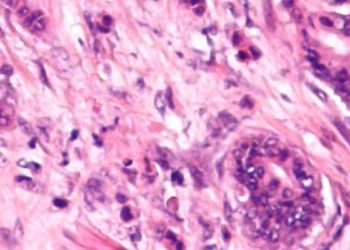2 Minute Medicine Rewind April 7, 2025
1. The highest-ranking phenotypic predictors of head and neck cancer included past tobacco smoking, job code at baseline, pain experienced during the last month, qualifications, FVC (Z score), and blood pressure.
2. Single nucleotide polymorphisms were less important in predicting the risk of head and neck cancer than phenotypic variables.
Evidence Rating Level: 2 (Good)
Head and neck cancer (HNC) refers to malignant tumors in the nasal cavity, oral cavity, pharynx, and larynx and accounts for over 300,000 deaths worldwide. 50-75% of these cases are diagnosed at the “advanced” stage, creating the need for risk prediction models. This retrospective biobank study looked at 502,367 participants from the UK Biobank between 2006 and 2021 to identify the relative importance of known risk factors and to identify novel risk factors. Data on potential risk factor exposure was collected through questionnaires/interviews, phenotype screening, and genetic testing. At baseline, men were more likely to get HNC (p < 0.001). Additionally, HNC was associated with poor or fair overall health rating, lower BMI with lower body fat percentage, engaged in less physical activity, had long standing illness/disability, more medications taken, high blood pressure, greater hand grip strength, pain during the past month, lower household income, lower educational attainment, and used tobacco. Incident cases were more likely to drink alcohol, smoke, have wheezing in the chest, experience shortness of breath with walking, and consume processed meat 2-4 times/week. There is also a significant difference in single-nucleotide polymorphisms (SNPs) between HNC incident cases and controls (p < 0.001), including rs259919-G (ZNRD1ASP gene) SNPs being more common in HNC incidences whereas rs1131769-T (STING1 gene) and rs28419191-T (ECSCR – SMIM33 gene) SNPs were more prevalent in controls. The highest-ranking phenotypic predictors of head and neck cancer included past tobacco smoking, job code at baseline, pain experienced during the last month, qualifications, FVC (Z score), and blood pressure. Single nucleotide polymorphisms were less important in predicting risk of head and neck cancer than phenotypic variables as none of the studied 25 genes were in the top 50 predictors of HNC.
1. A two-minute walk test is less robust in measuring the stead state metabolic expenditure in lower leg amputee patients compared to total oxygen uptake analysis and minute interval analysis over 6 minutes, but it can still be accurately used if these tests are not tolerated.
Evidence Rating Level: 2 (Good)
When comparing prosthetic devices, interventions or populations, assessing the energy expenditure through metabolic demand during a six-minute walk test is the current standard. For patients with lower-limb amputations, this test can be very difficult or impossible. Additionally, an analysis of healthy adults showed that 96.8% of walking sessions lasted less than three minutes, further making a six-minute test less representative of real-world conditions. The challenge with shorter walking assessments is they do not allow participants to reach a steady state (SS) of energy expenditure, though recent studies have shown health adults can reach SS in 2 minutes. Additionally, other metrics such as oxygen uptake analysis and slope analysis of metabolic measures have been shown to correlate well with longer walking tests. Together, this makes the two-minute walk test (2MWT) a promising option for metabolic testing in lower-limb amputee populations. This study aimed to validate the 2MWT in these patients. They included individuals with transfemoral amputation (TF group), transtibial amputation (TT group), or no amputation (NoAmp group). Participants were assessed for a 2-minute total oxygen uptake, minute intervals over 6 minutes, and the 2MWT. All participants had amputations due to non-dysvascular causes. In total oxygen use testing, there were significant correlations between total oxygen consumption and steady state oxygen consumption for all three groups (p <0.05). During the minute interval analysis, SS was significantly correlated with nearly all metabolic measures including O2 consumption, O2, cost, and heart rate. Finally, the 2MWT showed fewer correlations with the SS and significant outcomes were also weaker compared to total oxygen uptake or minute interval analyses. Therefore, the 2MWT is an inferior test for SS in lower leg amputee patients than total oxygen uptake analysis and minute interval analysis. However, since there is some correlation, in the instance a longer walk test cannot be tolerated, a 2MWT can be used.
1. App-based interventions enhanced psychological readiness for activity but did not translate to increased moderate-to-vigorous physical activity in this already-active cohort
Evidence Rating Level: 1 (Excellent)
This randomized clinical trial evaluated two app-based interventions designed to increase moderate-to-vigorous physical activity (MVPA) among 619 women with prior hypertensive pregnancy disorder (HPD), a population at elevated cardiovascular risk. Participants were randomized into three groups: a control group receiving general health information, a motivation group adding motivational interviewing techniques, and an action group incorporating additional behavior change strategies (goal-setting, planning, and mindfulness). All participants used a wearable activity tracker and a purpose-built app over 8 weeks, with MVPA measured as the primary outcome. Despite high baseline activity levels (mean 242 minutes/week, exceeding WHO guidelines), MVPA declined modestly post-intervention across all groups (197 minutes/week at 9 weeks), with no significant treatment effects observed (action group: −17 min/week [95% CI, −58 to 23]; motivation group: −3 min/week [−58 to 51]). Notably, the action intervention improved motivational and volitional psychological processes (e.g., coping planning increased by 0.9 SD) but failed to influence automatic processes like stress or affect. Subgroup analysis suggested a potential benefit for those with low baseline MVPA (interaction effect: +86 min/week at 9 weeks), though this did not withstand multiple-testing correction. Key limitations included high attrition (71% by 12 months) and baseline activity levels potentially creating a ceiling effect. The app was well-received, with 66–77% module completion rates. While app-based interventions enhanced psychological readiness for activity, they did not translate to increased MVPA in this already-active cohort. Future interventions might target automatic processes or focus on inactive subgroups. The findings underscore the challenge of bridging the intention-behavior gap, even with theory-driven tools.
1. In high-risk patients, point-of-care capillary HbA1c was superior to venous HbA1c as uptake was double, leading to faster results, fewer repeat visits, and identified more undiagnosed Type 2 Diabetes Mellitus.
Evidence Rating Level: 1 (Excellent)
This cluster randomized controlled trial evaluated point-of-care capillary HbA1c (POC-cHbA1c) versus standard venous HbA1c (vHbA1c) for type 2 diabetes (T2D) screening across 8 Hong Kong primary care clinics. Among 852 high-risk patients (mean age 58, 62% female), POC-cHbA1c demonstrated superior performance: screening uptake was double that of vHbA1c (76.0% vs 37.5%, OR=7.06, p<0.001), attributed to immediate results and avoidance of repeat visits. The intervention identified significantly more undiagnosed T2D (4.2% vs 1.4%, p=0.016) and prediabetes (11.8% vs 6.9%, p=0.015), requiring only 61 screenings to detect one additional diabetes case. Notably, 40.7% of POC-cHbA1c tests showed elevated levels (≥5.6%) versus 27.5% for vHbA1c, with better subsequent OGTT completion (33.5% vs 22.7%, p<0.001). Mixed-effects modeling confirmed POC-cHbA1c’s advantage even after adjusting for clustering and covariates (OR=1.99 for combined diabetes/prediabetes detection, p=0.048). The findings suggest POC-cHbA1c’s logistical advantages – including same-visit testing and reduced patient burden – could transform early diabetes detection in resource-constrained primary care settings, though further studies should evaluate long-term glycemic outcomes and the cost-effectiveness of this screening approach.
Role of Central Sensitization Syndrome in Patients With Autonomic Symptoms
1. Central sensitization syndrome is present in most patients with chronic autonomic concerns
2. Patients with central sensitization syndrome reported worse autonomic symptoms despite showing less severe objective autonomic dysfunction
Evidence Rating Level: 2 (Good)
This study investigated the role of central sensitization syndrome (CSS) in patients with chronic autonomic symptoms unexplained by objective testing, hypothesizing that CSS amplifies symptoms through disrupted interoceptive processing. Researchers conducted a retrospective case-control analysis of 555 patients with orthostatic intolerance, assessing autonomic function (Valsalva maneuver, tilt testing, sudomotor evaluation) and patient-reported outcomes (Central Sensitization Inventory [CSI], Compass-31, Neuropathy Total Symptom Score-6). CSS (CSI≥40) was present in 78% of participants, who were predominantly younger females with longer symptom duration and higher rates of comorbidities like fibromyalgia and anxiety compared to non-CSS patients. While both groups showed autonomic failure (AF), CSS patients reported significantly worse symptoms (higher Compass-31 and NTSS-6 scores, strongly correlated with CSI) despite less severe objective AF (mean AF scores 4.21 vs. 5.23, p=0.021). Notably, CSS patients demonstrated greater orthostatic cerebral blood flow decline (p<0.001) and hypocapnia (p=0.004), suggesting central dysregulation contributes to symptom amplification. These findings indicate CSS is prevalent in autonomic dysfunction and may explain symptom-sign discordance, emphasizing the need for dual treatment targeting both CSS and AF. For clinicians, recognizing CSS in patients with disproportionate symptoms can guide more comprehensive management strategies.
Image: PD
©2025 2 Minute Medicine, Inc. All rights reserved. No works may be reproduced without expressed written consent from 2 Minute Medicine, Inc. Inquire about licensing here. No article should be construed as medical advice and is not intended as such by the authors or by 2 Minute Medicine, Inc.







![Fluorophores enhance visualization for image-guided surgery [PreClinical]](https://www.2minutemedicine.com/wp-content/uploads/2015/01/FISH_13_21-75x75.jpg)